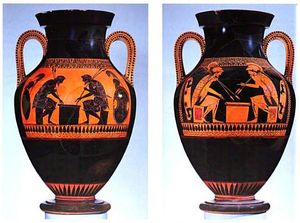As autumn descends upon us, we consider an analect for today which reflects our longing for the diminishing sun—and how we should consider our lives in the grand scheme, not necessarily just on our proximity to warmth:
I know no one. But nevertheless I pity the poor wretch even though he is my enemy, because he has been yoked harshly to the harness of a dreadful delusion. Yes, I ponder that man’s lot no less than my own. For I see that we are nothing more than ghosts — all we that live — or vacuous insubstantial shadows.
– Ajax, in Sophocles’ Ajax

About this image: “Andokides Painter, Achilles and Ajax playing a dice game (Attic bilingual amphora), from Orvieto, Italy, ca. 525-520 BCE. Black-figure side (left) and red-figure side (right). Approx. 1′ 9″ high. Museum of Fine Arts, Boston.” As appears in Gardner’s art through the ages: a western perspective, by Helen Gardner, Fred S. Kleiner, and Christin J. Mamiya (2006), page 108. A few comments from our art history major student office assistant, Sarah Cole:
Amphorae were commonly used as funerary markers and storage vessels in Ancient Greece. This amphora shows great craftsmanship and skill. Before the Black Figure and Red Figure styles were created, the artist would paint the image onto the vessel with slip. With the new techniques, the image could be scratched onto the vessel, which allowed more detail. This image shows two great warriors at a moment before battle. Often, artists created scenes of great battles or mythology for the main image. The figures hold their spears but the shields stand to the side. On the Black figure vase, the shield to the right is a Dipylon shield, which was used by soldiers in the Bronze Age.
